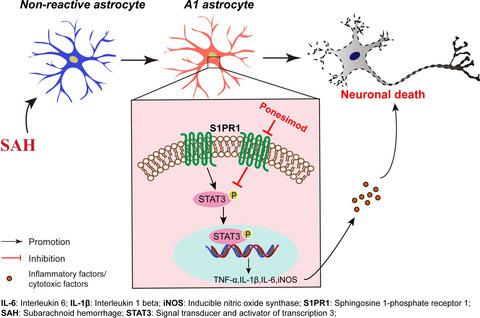当前位置:
X-MOL 学术
›
J. Neurochem.
›
论文详情
Our official English website, www.x-mol.net, welcomes your feedback! (Note: you will need to create a separate account there.)
Ponesimod protects against neuronal death by suppressing the activation of A1 astrocytes in early brain injury after experimental subarachnoid hemorrhage
Journal of Neurochemistry ( IF 4.7 ) Pub Date : 2021-06-18 , DOI: 10.1111/jnc.15457 Lifang Zhang 1, 2, 3, 4 , Kecheng Guo 1, 4, 5 , Jian Zhou 1, 2, 4 , Xianhui Zhang 4, 5 , Shigang Yin 4, 5 , Jianhua Peng 1, 2, 3, 4 , Yuyan Liao 1, 4, 5 , Yong Jiang 1, 2, 3, 4
Journal of Neurochemistry ( IF 4.7 ) Pub Date : 2021-06-18 , DOI: 10.1111/jnc.15457 Lifang Zhang 1, 2, 3, 4 , Kecheng Guo 1, 4, 5 , Jian Zhou 1, 2, 4 , Xianhui Zhang 4, 5 , Shigang Yin 4, 5 , Jianhua Peng 1, 2, 3, 4 , Yuyan Liao 1, 4, 5 , Yong Jiang 1, 2, 3, 4
Affiliation

|
As an important initiator and responder of brain inflammation in the central nervous system (CNS), astrocytes transform into two new reactive phenotypes with changed morphology, altered gene expression and secretion profiles, termed detrimental A1 and beneficial A2. Inflammatory events have been shown to occur during the phase of early brain injury (EBI) after subarachnoid hemorrhage (SAH). However, the phenotype transformation of astrocytes as well as its potential contribution to inflammatory status in the EBI of SAH has yet to be determined. In the present study, both in vivo and in vitro models of SAH were established, and the polarization of astrocytes after SAH was analyzed by RNA-seq, western blotting, and immunofluorescence staining. The effect of astrocytic phenotype transformation on neuroinflammation was examined by real-time quantitative PCR (RT-qPCR) and enzyme-linked immunosorbent assay (ELISA). We demonstrated that astrocytes were transformed into A1 astrocytes and caused neuronal death through the release of pro-inflammatory factors in EBI after SAH. Importantly, Ponesimod, an S1PR1 specific modulator, exerted neuroprotective effects through the prevention of astrocytic polarization to the A1 phenotype as proved by immunofluorescence, neurological tests, and TUNEL study. We also revealed the role of Ponesimod in modulating astrocytic response was mediated by the signal transducer and activator of transcription 3 (STAT3) signaling. Our study suggested that Ponesimod may be a promising therapeutic target for the treatment of brain injury following SAH.
中文翻译:

Ponesimod 通过抑制实验性蛛网膜下腔出血后早期脑损伤中 A1 星形胶质细胞的活化来防止神经元死亡
作为中枢神经系统 (CNS) 中脑炎症的重要发起者和反应者,星形胶质细胞转变为两种新的反应性表型,其形态改变、基因表达和分泌谱改变,称为有害 A1 和有益 A2。已显示炎症事件发生在蛛网膜下腔出血 (SAH) 后的早期脑损伤 (EBI) 阶段。然而,星形胶质细胞的表型转化及其对 SAH EBI 炎症状态的潜在贡献尚未确定。在本研究中,建立了体内外SAH模型,并通过RNA-seq、蛋白质印迹和免疫荧光染色分析了SAH后星形胶质细胞的极化。通过实时定量 PCR (RT-qPCR) 和酶联免疫吸附试验 (ELISA) 检测星形胶质细胞表型转化对神经炎症的影响。我们证明星形胶质细胞转化为 A1 星形胶质细胞,并通过 SAH 后 EBI 中促炎因子的释放导致神经元死亡。重要的是,免疫荧光、神经学测试和 TUNEL 研究证明,Ponesimod 是一种 S1PR1 特异性调节剂,通过防止 A1 表型的星形细胞极化来发挥神经保护作用。我们还揭示了 Ponesimod 在调节星形胶质细胞反应中的作用是由信号转导和转录激活因子 3 (STAT3) 信号介导的。我们的研究表明,Ponesimod 可能是治疗 SAH 后脑损伤的有希望的治疗靶点。
更新日期:2021-08-19
中文翻译:

Ponesimod 通过抑制实验性蛛网膜下腔出血后早期脑损伤中 A1 星形胶质细胞的活化来防止神经元死亡
作为中枢神经系统 (CNS) 中脑炎症的重要发起者和反应者,星形胶质细胞转变为两种新的反应性表型,其形态改变、基因表达和分泌谱改变,称为有害 A1 和有益 A2。已显示炎症事件发生在蛛网膜下腔出血 (SAH) 后的早期脑损伤 (EBI) 阶段。然而,星形胶质细胞的表型转化及其对 SAH EBI 炎症状态的潜在贡献尚未确定。在本研究中,建立了体内外SAH模型,并通过RNA-seq、蛋白质印迹和免疫荧光染色分析了SAH后星形胶质细胞的极化。通过实时定量 PCR (RT-qPCR) 和酶联免疫吸附试验 (ELISA) 检测星形胶质细胞表型转化对神经炎症的影响。我们证明星形胶质细胞转化为 A1 星形胶质细胞,并通过 SAH 后 EBI 中促炎因子的释放导致神经元死亡。重要的是,免疫荧光、神经学测试和 TUNEL 研究证明,Ponesimod 是一种 S1PR1 特异性调节剂,通过防止 A1 表型的星形细胞极化来发挥神经保护作用。我们还揭示了 Ponesimod 在调节星形胶质细胞反应中的作用是由信号转导和转录激活因子 3 (STAT3) 信号介导的。我们的研究表明,Ponesimod 可能是治疗 SAH 后脑损伤的有希望的治疗靶点。



























 京公网安备 11010802027423号
京公网安备 11010802027423号